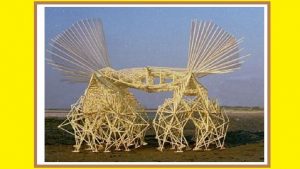
Jansen once studied physics, leaving it to become a painter. He combined the two to create painting machines, but brought them both to their final use in the creation of the Animari. He has been “evolving” his beach-walking creations, choosing the best parts from each of his multi-legged creatures to make stronger and better units.
He began with an 11-piece leg designed with computer algorithms, but has since evolved them to propel themselves from wind energy, to sense obstacles, and to even anchor themselves down for a storm.
His hope is that the mechanical beasts will evolve to become so autonomous that they will survive him, grazing on the wind of the Dutch sea-side long after his death.











































